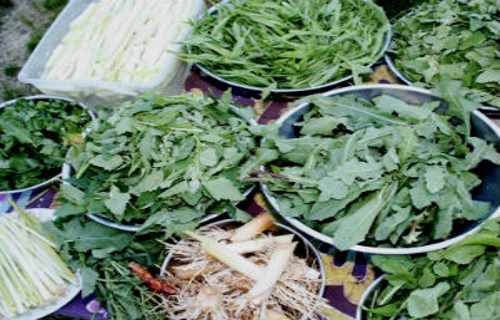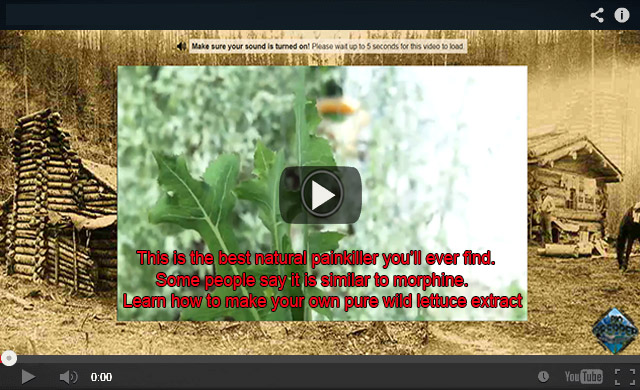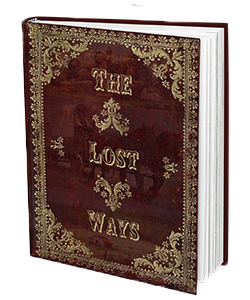Wild edibles exist almost everywhere and are in abundance if you feel like foraging for them. Edible wild food has existed in almost every corner of our planet for tens of thousands of years. Edible weeds, flowers and wild herbs were foraged and used as food (as well as medications); and they provided all the vitamins, minerals and other nutrients required for the human body to maintain good health. Foraging for food used to be the way to survive.
Edible ‘Weeds’ will be different depending on where you live in the world. Some are fairly universal though so you can find quite a few delicious recipes online that use nettles, dandelion leaves, sorrel, and more. Foraging for and learning which ones suit your taste can be a fun and adventurous culinary experience though please make sure that you know what you’re picking before you take it home and put it in a salad. Whereas some plants are unmistakable, others are more difficult and can be confused for toxic species.
Chances are edible weeds are in your backyard, on pathways you walk every day, or in fields you see every day. Many of these plants can be foraged and added to your daily diet to increase your nutritional intake.
There’s a plethora of wild herbs, weeds, flowers, shrubs, trees and vines all safe to eat so long as you identify them properly and know what part of the plant is usable!
Learn How to Survive on Wild Edibles in Winter
Winter Survival Food is our latest book that shows you how to forage for food in the winter time. Extended power outages can and do happen. if our power grid went down and stayed down form an extended duration of time? How would you get the nutrients your body needs to survive? Winter Survival Food contains valuable information on how to survive on wild edibles during the winter months.
- • Plant identification
- • Harvesting and preserving
- • Nutritional and medicinal information
- • Health benefits
- • Photographs and recipe ideas
- • Interesting facts and history
Benefits of Wild Edible Plants
There are numerous benefits to eating wild edibles such as:
- They are free.
- They are genetically stronger than other food.
- Longer root systems make most weeds drought-resistant.
- Most edible plants and weeds are more nutritious than hybridized store produce.
- Eating local wild plants means that the plant fights off the same organisms as your body therefore making them highly beneficial for the immune system.
- Wildcrafting (picking your own) edibles means you get exercise, vitamin D (sunshine) and get to be in a natural, relaxing setting.
Why Should You Eat Dandelion Greens?
I see people pulling their dandelion, cursing it, kicking it and spraying chemicals all around it.
What people don’t know is that this jagged edged green weed that causes them so much trouble is a powerhouse healing herb full of worthy nutrients.
Most everyone could prosper from the high content of Vitamins A, C and E that this herb imparts.
Dandelion is free, grows without care and then we pull it up and poison it, what an interesting paradox. What we need is right in front of us, yet we go to extended trouble to eradicate it. This gives us a glimpse into our sometimes upside down relationship with nature.
The fruitful uses of this plant go on and on. Its’ nutritive qualities alone are reason enough to incorporate it into your diet.
I put it into my salad and salad dressings.
Dandelion leaf is bitter which is a flavor that we need more of in our diet. The common American menu is laden with sugar and low quality salt. Sweet and salty are the tastes that most people crave. If bitters are new territory, it can take a little getting used to. Once you take up residence with bitter foods you notice how much more robust your digestion is and you too will develop a hankering for more bitter flavors in your dinner.
The bitter taste of dandelion leaf increases the flow of saliva which contains antibacterial substances and enzymes that support the breakdown of your food.
Dandelion leaf not only enhances saliva production but stimulates digestive secretions throughout the digestive tract. It enhances the strength of peristalsis and stimulates the flow of stomach secretions and other helpful digestive substances.
The salivation that is stimulated by the bitter flavor of dandelion is an invaluable aspect of nutrient assimilation. This initial digesting and disinfection is done in the mouth so the rest of the digestive tract doesn’t have to do it. It isn’t something that makes a difference in one day, but over time, a lifestyle of taking bitter; saliva enhancing herbs means better health.
Try mincing up 4 or 5 fresh dandelion leaves from your weed patch the next time you make salad. Cut the leaves into very small pieces and mix them in with the rest of your fresh salad greens or cooked greens.
Soon you will tell others about the joy of bitterness!
Alfalfa
Alfalfa is typically used for livestock, but it can also be a nutrient dense food for humans. Leaves and young shoots can be eaten raw, cooked, or made into tea. People with lupus should not eat alfalfa as it can trigger attacks.
Alfalfa
Broadleaf plantain
Broadleaf plantain leaves can be eaten raw or cooked when young. The seeds can also be eaten.
Broadleaf Plantain
Chickweed
Chickweed leaves are typically eaten raw in salads. I really like chickweed because it is one of the first things to grow in the early spring when you don’t have much else to eat in the garden.
Dandelion
Dandelion is probably the most well-known edible “weed”. Leaves can be used in salads fresh or cooked, although I do find them to be a little bitter. They can also be used in making tea. The root can even be made into a coffee substitute.
Henbit
Henbit’s leaves, flowers, and stem are all edible and can be eaten raw or cooked. Henbit is a cool season annual like chickweed, so it provides valuable nutrients, pollen, and nectar early in the season.
Henbit (A winter annual)
Lambsquarters
Lambsquarters leaves, flowers, and seeds are edible. I use the leaves raw in salads in small quantities. They taste fine to me, not unlike spinach, although I do prefer spinach. The seeds and leaves can be toxic, so I wouldn’t overdo it with this one, although it has never given me any problems.
Lambsquarters
Milkweed
Milkweed can be eaten as a cooked young shoot. The flowers can be eaten as well as the unopened flower heads. The flower heads look a lot like broccoli, and are often times fried in batter.
Milkweed
Purslane
Purslane leaves can be eaten fresh. Stems and flowers can also be eaten.
Purslane
Purple Clover
Purple Clover has a flower that is a great edible, and its leaves can also be used in salads.
Purple Clover
Wood Sorrel
Wood Sorrel has many edible parts. The leaves, flowers, and green seed pods can all be eaten fresh. It has a slight lemon flavor, but should not be eaten in high quantities because of the oxalic acid it contains.
Wood Sorrel
Yarrow
Yarrow flowers and leaves can be made into a nutritious tea. Young leaves can also be eaten fresh in a salad or cooked, although they can be very bitter.
I believe every family needs to have someone on board with a working knowledge of natural remedies if you want to take care of your family’s health for real.
When I was growing up, natural remedies was not a mainstream concept like it is now, in fact, you are going to be surprised that I never even heard the word natural remedy until I moved out of the house!
Learning to cook from your deep pantry can made easier with the following books:
The Lost Ways (Learn the long forgotten secrets that helped our forefathers survive famines,wars,economic crisis and anything else life threw at them)
Our grandfathers had more knowledge than any of us today and thrived even when modern conveniences were not available. They were able to produce and store their food for long periods of time. The Lost Ways is the most comprehensive book available. All the knowledge our grandfathers had, in one place.Here’s just a glimpse of what you’ll find in the book:
Table Of Contents:
Making Your Own Beverages: Beer to Stronger Stuff
Ginger Beer: Making Soda the Old Fashioned Way
How North American Indians and Early Pioneers Made Pemmican
Wild West Guns for SHTF and a Guide to Rolling Your Own Ammo
How Our Forefathers Built Their Sawmills, Grain Mills,and Stamping Mills
How Our Ancestors Made Herbal Poultice to Heal Their Wounds
What Our Ancestors Were Foraging For? or How to Wildcraft Your Table
How North California Native Americans Built Their Semi-subterranean Roundhouses
Our Ancestors’Guide to Root Cellars
Good Old Fashioned Cooking on an Open Flame
Learning from Our Ancestors How to Preserve Water
Learning from Our Ancestors How to Take Care of Our Hygiene When There Isn’t Anything to Buy
How and Why I Prefer to Make Soap with Modern Ingredients
Temporarily Installing a Wood-Burning Stove during Emergencies
Making Traditional and Survival Bark Bread…….
Trapping in Winter for Beaver and Muskrat Just like Our Forefathers Did
How to Make a Smokehouse and Smoke Fish
Survival Lessons From The Donner Party
Get your paperback copy HERE
Here’s just a glimpse of what you’ll find in The Lost Ways:
From Ruff Simons, an old west history expert and former deputy, you’ll learn the techniques and methods used by the wise sheriffs from the frontiers to defend an entire village despite being outnumbered and outgunned by gangs of robbers and bandits, and how you can use their wisdom to defend your home against looters when you’ll be surrounded.
Native American ERIK BAINBRIDGE – who took part in the reconstruction of the native village of Kule Loklo in California, will show you how Native Americans build the subterranean roundhouse, an underground house that today will serve you as a storm shelter, a perfectly camouflaged hideout, or a bunker. It can easily shelter three to four families, so how will you feel if, when all hell breaks loose, you’ll be able to call all your loved ones and offer them guidance and shelter? Besides that, the subterranean roundhouse makes an awesome root cellar where you can keep all your food and water reserves year-round.
From Shannon Azares you’ll learn how sailors from the XVII century preserved water in their ships for months on end, even years and how you can use this method to preserve clean water for your family cost-free.
Mike Searson – who is a Firearm and Old West history expert – will show you what to do when there is no more ammo to be had, how people who wandered the West managed to hunt eight deer with six bullets, and why their supply of ammo never ran out. Remember the panic buying in the first half of 2013? That was nothing compared to what’s going to precede the collapse.
From Susan Morrow, an ex-science teacher and chemist, you’ll master “The Art of Poultice.” She says, “If you really explore the ingredients from which our forefathers made poultices, you’ll be totally surprised by the similarities with modern medicines.” Well…how would you feel in a crisis to be the only one from the group knowledgeable about this lost skill? When there are no more antibiotics, people will turn to you to save their ill children’s lives.
If you liked our video tutorial on how to make Pemmican, then you’ll love this: I will show you how to make another superfood that our troops were using in the Independence war, and even George Washington ate on several occasions. This food never goes bad. And I’m not talking about honey or vinegar. I’m talking about real food! The awesome part is that you can make this food in just 10 minutes and I’m pretty sure that you already have the ingredients in your house right now.
Really, this is all just a peek.
The Lost Ways is a far–reaching book with chapters ranging from simple things like making tasty bark-bread-like people did when there was no food-to building a traditional backyard smokehouse… and many, many, many more!
Books can be your best pre-collapse investment.
The Lost Ways (Learn the long forgotten secrets that helped our forefathers survive famines,wars,economic crisis and anything else life threw at them)
Survival MD (Best Post Collapse First Aid Survival Guide Ever)
Conquering the coming collapse (Financial advice and preparedness )
Liberty Generator (Build and make your own energy source)
Backyard Liberty (Easy and cheap DIY Aquaponic system to grow your organic and living food bank)
Bullet Proof Home (A Prepper’s Guide in Safeguarding a Home )
Family Self Defense (Best Self Defense Strategies For You And Your Family)
Survive Any Crisis (Best Items To Hoard For A Long Term Crisis)
Survive The End Days (Biggest Cover Up Of Our President)















Yarrow is also invaluable as an antibiotic, blood-clotting wound dressing! I am horrible with knives and yarrow has spared me many trips to ER for stitches and the like! Use it in place of gauze and you will be amazed at its healing properties!